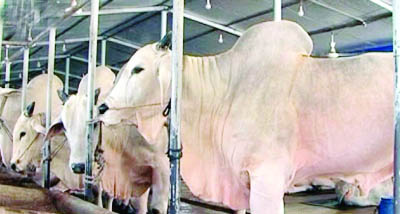
M.A. Awal, Narsingdi :
Cow-fattening, a practice developed for fetching high price by increasing the weight and size of a cow has been gaining popularity in this district for the last two decades.
According to District Livestock Department sources, there are 231 cow fattening projects in the district of them 28 in sadar upazila, 32 in Monahardi upazila, 52 in polash upazila, 66 in Raipura upazila, 35 in Shibpur upazila and 18 project in Belabo upazila of them Onunnah Dairy farm of Belabo upazial, Diganta Dair farm of Raipura upazila, Akata Dairy farm of polash upazila, Suman Dairy Farm of Monohardi Upazila, Sreekrishina Dairy farm of Shibpur upazila and Pakija Dairy Farm and Baki Dairy farm at Narsindi Sadar upazila are the main Each of these farm have started with 40 to 50 cows for fattening recently for setting enough money in the Eid-ul-Azha market.
Tracing the background of fattening cow, it is found that this practice was introduced in different ‘char’ areas particularly in river erosion threatened areas by Association for social advancement (ASH) aided by Production Employment Project (PEP) of BRDB.
The PEP with a view to create employment for the poor village women to be self reliant extended loan for rice husking, cattle rearing, duck and poultry rearing along with cow fattening.
According to a BRDB source these projects created enormous employment opportunities for poor women. However, the PEP suspended the loan programme with the stopping of financing by ASH.
But the cow fattening project is still very popular in this district. District Livestock Officer (DLO), Narsingdi Dr. Abdus Samad that about one thousand cows in six Upazillas of this district are now under intense care and nourishment of fattening programme.
“If everything goes well then each cow whose present weight is three maunds, it will be at least five to six mounds during Eid-ul-Azha,” he said.
Narrating the three months’ intense care, the DLO told The New Nation that very first approach to this practice begins with de- worming the targeted cow through using medicine orally or injecting anathematic drug (worm destroying drug), because worms resist growth of the cow.
Cow-fattening, a practice developed for fetching high price by increasing the weight and size of a cow has been gaining popularity in this district for the last two decades.
According to District Livestock Department sources, there are 231 cow fattening projects in the district of them 28 in sadar upazila, 32 in Monahardi upazila, 52 in polash upazila, 66 in Raipura upazila, 35 in Shibpur upazila and 18 project in Belabo upazila of them Onunnah Dairy farm of Belabo upazial, Diganta Dair farm of Raipura upazila, Akata Dairy farm of polash upazila, Suman Dairy Farm of Monohardi Upazila, Sreekrishina Dairy farm of Shibpur upazila and Pakija Dairy Farm and Baki Dairy farm at Narsindi Sadar upazila are the main Each of these farm have started with 40 to 50 cows for fattening recently for setting enough money in the Eid-ul-Azha market.
Tracing the background of fattening cow, it is found that this practice was introduced in different ‘char’ areas particularly in river erosion threatened areas by Association for social advancement (ASH) aided by Production Employment Project (PEP) of BRDB.
The PEP with a view to create employment for the poor village women to be self reliant extended loan for rice husking, cattle rearing, duck and poultry rearing along with cow fattening.
According to a BRDB source these projects created enormous employment opportunities for poor women. However, the PEP suspended the loan programme with the stopping of financing by ASH.
But the cow fattening project is still very popular in this district. District Livestock Officer (DLO), Narsingdi Dr. Abdus Samad that about one thousand cows in six Upazillas of this district are now under intense care and nourishment of fattening programme.
“If everything goes well then each cow whose present weight is three maunds, it will be at least five to six mounds during Eid-ul-Azha,” he said.
Narrating the three months’ intense care, the DLO told The New Nation that very first approach to this practice begins with de- worming the targeted cow through using medicine orally or injecting anathematic drug (worm destroying drug), because worms resist growth of the cow.

